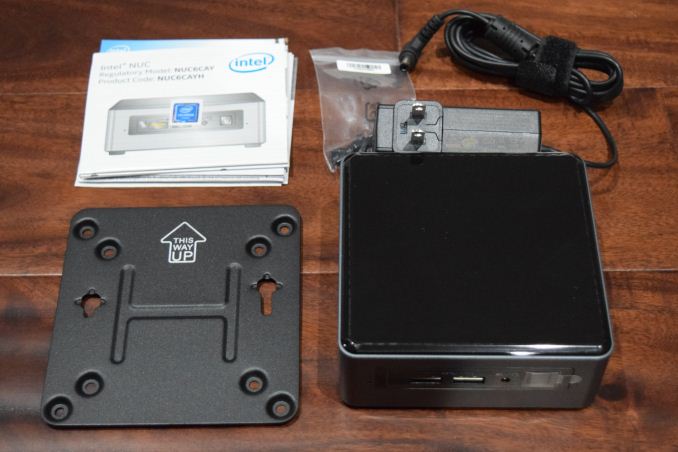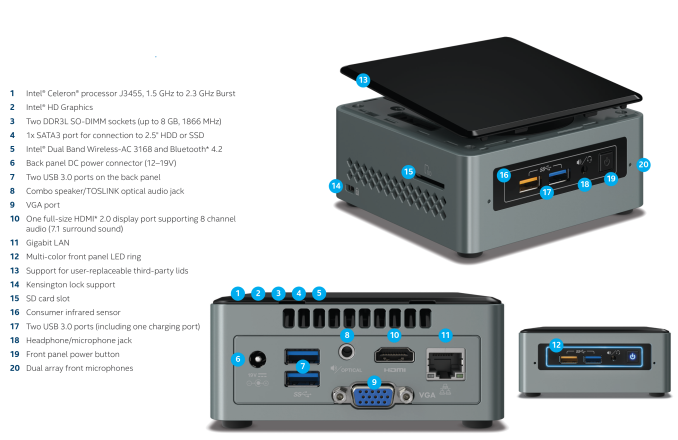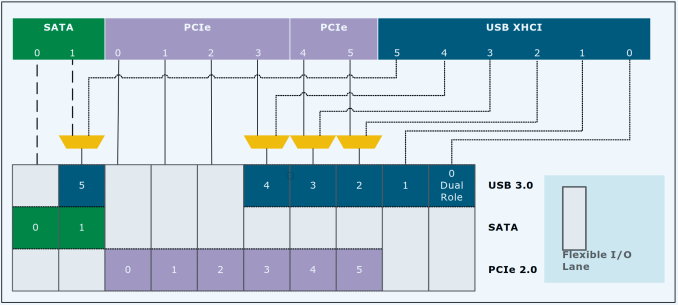Intel NUC6CAYH (Arches Canyon) Apollo Lake UCFF PC Review
by Ganesh T S on January 12, 2018 8:00 AM EST- Posted in
- Systems
- Intel
- NUC
- UCFF
- Apollo Lake
- Arches Canyon

Intel has enjoyed great success with their NUC lineup of ultra-compact form factor (UCFF) PCs. They have segmented the NUCs into three markets - the entry-level, mid-range, and enthusiast. The enthusiast segment is served by H series processors and the mid-range by the U series processors with the Core architecture. The entry level is served by Atom-class SoCs. Intel launched the Apollo Lake SoCs with the Goldmont CPU architecture in the second half of 2016. The NUC models employing one of the Apollo Lake SoCs was given the Arches Canyon codename.
Introduction and Product Impressions
The NUC6CAYH targets the entry-level and developing markets. It employs the same form factor as the previous-generation NUCs, and supports a 2.5" SATA drive (indicated by the H in the product code). Intel's Apollo Lake SoCs improve upon Bay Trail and Braswell by adopting a newer microarchitecture (Goldmont) for the CPU cores and also getting fabricated in a more power-efficient / mature 14nm process. In the consumer market, the Goldmont cores are exclusive to the Apollo Lake family. The SoCs target the netbook and nettop markets, with 6W and 10W TDP SKUs. We reviewed the ECS LIVA-ZN33 UCFF PC last year. It used a 6W TDP Celeron N3350 due to its fanless nature. The Intel NUC6CAYH, however, is actively cooled, and goes for the Celeron J3455 with a 10W TDP.
Arches Canyon has two SKUs - the NUC6CAYH, and the NUC6CAYS. The main difference between the two is that the NUC6CAYH is barebones, while the NUC6CAYS is ready to use out of the box. The 'S' SKU has a 2GB DDR3L SO-DIMM pre-installed, along with 32GB of eMMC flash on the board. Windows 10 Home x64is also pre-installed. We received the NUC6CAYH for review, and completed the configuration with a Corsair Vengeance CMSX8GX3M2B1866C10 DDR3 SODIMM kit (2x 4GB) and a 500GB Crucial MX200 SSD. The full specification of our review configuration is summarized in the table below.
| Intel NUC6CAYH Specifications | |
| Processor | Intel Celeron J3455 Apollo Lake (Goldmont), 4C/4T, 1.5 - 2.3 GHz, 14nm, 2 MB L2, 10W TDP |
| Memory | Corsair Vengeance CMSX8GX3M2B1866C10 DDR3 10-10-10-32 @ 1866 MHz 2x4 GB |
| Graphics | Intel HD Graphics 500 |
| Disk Drive(s) | Crucial MX200 CT500MX200SSD1 (500 GB; 2.5in SATA 6Gb/s; 16nm; MLC) |
| Networking | Intel Dual Band Wireless-AC 3168 (1x1 802.11ac - 433 Mbps) 1x Realtek RTL8168/8111 Gigabit LAN |
| Audio | 3.5mm Headphone Jack Capable of 5.1/7.1 digital output with HD audio bitstreaming (HDMI) |
| Miscellaneous I/O Ports | 2x USB 3.0 Type-A (rear) 2x USB 3.0 Type-A (front) 1x SDXC |
| Operating System | Retail unit is barebones, but we installed Windows 10 Pro x64 |
| Pricing | $130 (barebones) / $470 (as configured) |
| Full Specifications | Intel NUC6CAYH Specifications |
The NUC6CAYH package comes with a 65W (19V @ 3.42A) AC adapter and a VESA mount / screws in addition to the main unit.
One of the interesting aspects of the NUC6CAYH is the integrated dual-array microphone. This allows the end user to configure it as an always-listening machine (if needed), without the need to connect an external microphone. The other selling point is the availability of a HDMI 2.0 port with HDCP 2.2 support. 4Kp60 capability is present, allowing for specific digital signage use-cases. It also lends itself to usage as a HTPC capable of driving a 4K display.
Platform Analysis
The specifications of the Intel Celeron J3455 indicate that the SoC can support up to 6 PCIe 2.0 lanes, 2 SATA ports, and 8 USB ports. The break-up of the high-speed I/O lanes is interesting in the context of the four USB 3.0 ports and SDXC slot in the NUC6CAYH.
Intel Celeron J3455 HSIO Block Diagram [ Courtesy : Intel Pentium and Celeron Processor N- and J- Series Datasheet - Volume 1 of 3 (PDF) ]
The distribution of PCIe lanes in the NUC6CAYH is as below.
- PCI-E 2.0 x1 port #0 In Use @ x1 (Realtek RTS5229 PCIe Card Reader )
- PCI-E 2.0 x1 port #1 In Use @ x1 (Realtek RTL8168/8111 PCI-E Gigabit Ethernet Adapter)
- PCI-E 2.0 x1 port #2 In Use @ x1 (Intel Dual Band Wireless-AC 3168 WiFi Adapter)
Since none of the PCIe lanes are multiplexed with the USB 3.0 lanes, we do not have any bandwidth-sharing issues or bottlenecks.
In the table below, we have an overview of the various systems that we are comparing the Intel NUC6CAYH against. Note that they may not belong to the same market segment. The relevant configuration details of the machines are provided so that readers have an understanding of why some benchmark numbers are skewed for or against the Intel NUC6CAYH when we come to those sections.
| Comparative PC Configurations | ||
| Aspect | Intel NUC6CAYH | |
| CPU | Intel Celeron J3455 | Intel Celeron J3455 |
| GPU | Intel HD Graphics 500 | Intel HD Graphics 500 |
| RAM | Corsair Vengeance CMSX8GX3M2B1866C10 DDR3 10-10-10-32 @ 1866 MHz 2x4 GB |
Corsair Vengeance CMSX8GX3M2B1866C10 DDR3 10-10-10-32 @ 1866 MHz 2x4 GB |
| Storage | Crucial MX200 CT500MX200SSD1 (500 GB; 2.5in SATA 6Gb/s; 16nm; MLC) |
Crucial MX200 CT500MX200SSD1 (500 GB; 2.5in SATA 6Gb/s; 16nm; MLC) |
| Wi-Fi | Intel Dual Band Wireless-AC 3168 (1x1 802.11ac - 433 Mbps) |
Intel Dual Band Wireless-AC 3168 (1x1 802.11ac - 433 Mbps) |
| Price (in USD, when built) | $130 (Barebones) $470 (as configured / No OS) |
$130 (Barebones) $470 (as configured / No OS) |













54 Comments
View All Comments
ganeshts - Friday, January 12, 2018 - link
Have you looked at the prices of RAM and flash lately? The Corsair kit was $90 when I was writing this review a week or so back (looks like it is $80 today), and the MX200 is relatively rare to find now (it was $250 when I was writing this). I think the cheapest equivalent today would be the BX300 480GB @ $145. So, the $470 price at the time of writing is probably closer to $355 now.That said, RAM and flash prices are fluctuating wildly due to the recent shortage. Things ought to become stable and a bit cheaper soon.
powellandy - Friday, January 12, 2018 - link
Do you have any comment on the ability to play 3D - looks like it's an ongoing saga with Intel chips -https://communities.intel.com/thread/112109
bill44 - Saturday, January 13, 2018 - link
Been following that thread, which is now dead. Intel won't/can't fix it. If they could, they've done it by now. Not enough customer complained (not to mention, 3D for the industry is dead), as such it just gets dragged out until everyone gives up.Going into the future, native HDMI 2.x may fix the issue, but going by past experience, there will always be problems with a HTPC setup (check out MadVR Madshi forums regarding constant driver issues).
powellandy - Monday, January 15, 2018 - link
I agree, but I was hoping if they mention it in the review and perhaps ask Intel it would put a bit of pressure on them to fix it!bji - Friday, January 12, 2018 - link
Do the benchmarks include Meltdown and Spectre fixes? If they don't, then the numbers are not accurate.ganeshts - Friday, January 12, 2018 - link
The benchmark numbers were processed before the security fixes started coming in. The relative numbers are still accurate when you compare one unit against the other (all of them in the comparison graphs are Intel-based systems).We are waiting for the dust to settle on all security fixes before embarking on any benchmark numbers regeneration procedures.
satai - Friday, January 12, 2018 - link
Some comparison to Core Ms would be nice.fuzzymath10 - Friday, January 12, 2018 - link
It's just "feel" based, but I bought my NUC (the same one + old Intel 320 160GB + 8GB ram + W10 Pro) to play videos on my 4k TV. Before, I temporarily used my Venue 7140 Pro with the 5Y10. The 5Y10 is faster for pretty much any "normal" task such as internet browsing which shouldn't be a surprise. Raw multithreaded might be more similar but the Core M is a smoother overall experience.However, the NUC supports 4k @ 60Hz while the HDMI from my Venue is only good to 30Hz. The NUC IGP can also decode HEVC while the HD 5300 in the Venue cannot, and the 5Y10 is not fast enough to software-decode most HEVC content (neither can the J3455). The Core M is also passively cooled while the NUC is semi-passive (fan can shut off).
Unfortunately, Core M is also very expensive. However, I would say the jump in user experience from the NUC to Core M is greater than from Core M to my desktop (i7 3770).
lilmoe - Friday, January 12, 2018 - link
Call me when Intel is capable of delivering anything remotely equal in terms of video/streaming playback performance and efficiency as my 2 year old Galaxy S7.Such incompetence, what a joke.
Hixbot - Friday, January 12, 2018 - link
Are you kidding? This nuc is leaps and bounds more powerful that your smartphone.